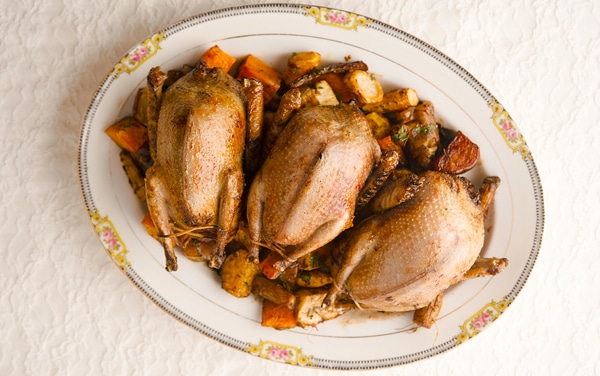Roux

A white roux
A roux-based sauce
Roux (/ˈruː/) is flour and fat cooked together and used to thicken sauces. Roux is typically made from equal parts of flour and fat by weight. The flour is added to the melted fat or oil on the stove top, blended until smooth, and cooked to the desired level of brownness. Clarified butter, vegetable oils, bacon drippings or lard are commonly used fats. Roux is used as a thickening agent for gravy, sauces, soups and stews. It provides the base for a dish, and other ingredients are added after the roux is complete.
The fat is most often butter in French cuisine, but may be lard or vegetable oil in other cuisines. The roux is used in three of the five mother sauces of classical French cooking: béchamel sauce, velouté sauce, and espagnole sauce.
In Cajun cuisine, roux is made with bacon fat or oil instead of butter and cooked to a medium or dark brown color, which lends much richness of flavor, albeit less thickening power.
Central European cuisine uses lard (in its rendered form) or more recently vegetable oil instead of butter for the preparation of roux, which is called zápražka in Slovak, jíška in Czech, zasmażka in Polish, zaprška (запръжка) in Bosnian, Croatian, Serbian, and Macedonian, zaprazhka (запръжка) in Bulgarian, rántás in Hungarian and Mehlschwitze in German.
Japanese curry, or karē (カレー), is made from a roux made by frying yellow curry powder, butter or oil, and flour together. The French term roux has become a loanword in Japanese, rū (ルー), or more specifically karērū (カレールー, curry roux).
Roux (meyane has been used in Ottoman and Turkish cuisine since at least the 15th century.
Methods
The fat is heated in a pot or pan, melting it if necessary. Then the flour is added. The mixture is heated and stirred until the flour is incorporated, and then cooked until at least the point where a raw flour taste is no longer apparent and the desired colour has been reached. The final colour can range from nearly white to nearly black, depending on the length of time it is heated and its intended use. The end result is a thickening and flavoring agent.
Roux is most often made with butter as the fat base, but it may be made with any edible fat. For meat gravies, fat rendered from meat is often used. In regional American cuisine, bacon is sometimes rendered to produce fat to use in the roux. If clarified butter is not available, vegetable oil is often used when producing dark roux, since it does not burn at high temperatures, as whole butter would.
Types[edit]
Light (or "white") roux provides little flavor other than a characteristic richness to a dish, and is used in French cooking and some gravies or pastries throughout the world.
Darker roux are made by browning the flour in oil for a longer time, and add a distinct nutty flavor to a dish. They may be called "blond", "peanut-butter", "brown" or "chocolate" roux depending on their color. The darker the color, the richer the flavor.
Swabian (southwest German) cooking uses a darker roux for its "brown broth" (braune Brühe), which, in its simplest form, consists of nothing more than lard, flour, and water, with a bay leaf and salt for seasoning. Dark roux is often made with vegetable oils, which have a higher smoke point than butter, and are used in Cajun and Creole cuisine for gumbos and stews. The darker the roux, the less thickening power it has; a chocolate roux has about one-fourth the thickening power, by weight, of a white roux. A very dark roux, just shy of burning and turning black, has a distinctly reddish color and is sometimes referred to as "brick" roux.

A dish of staka served as part of a meze, Souda, Crete
Cretan staka
Staka (στάκα) is a type of roux particular to Cretan cuisine. It is prepared by cooking goat milk cream over a low flame with wheat flouror starch: the protein-rich part of the butterfat coagulates with the flour or starch and forms the staka proper, which is served hot. It is generally eaten by dipping bread in it, occasionally served over French fries.
The fatty part separates to form stakovoutyro, staka butter, which is kept for later use and has a faint cheesy flavor. Staka butter is used in Cretan pilaf (piláfi), commonly served at weddings.
Alternatives
Cooks can substitute for roux by adding a mixture of cold water and wheat flour to a dish that needs thickening, since the heat of boiling water will release the starch from the flour; however, this temperature is not high enough to eliminate the floury taste. A mixture of water and flour used in this way is colloquially known as “cowboy roux”, and in modern cuisine it is called a white wash. It is used infrequently in restaurant cooking, since it imparts a flavor to the finished dish that a traditional haute cuisine chef would consider unacceptable. Cornflour (known as cornstarch in the United States) can be used instead of wheat flour, as less is needed to thicken, it imparts less of the raw flour taste, and it also makes the final sauce more shiny.
As an alternative to roux, which is high in fat and very energy-dense, some Creole chefs have experimented with toasting flour without oil in a hot pan as an addition to gumbo. Cornstarch mixed with water (slurry), arrowroot, and other agents can be used in place of roux as well. These items do not contribute to the flavor of a dish, and are used solely for thickening liquids. More recently, many chefs have turned to a group of naturally occurring chemicals known as hydrocolloids. In addition to being flavorless and possessing the ability to act as a thickening agent, the resulting texture is thought by some to be superior,[citation needed] and only a small amount is required for the desired effect.




















:max_bytes(150000):strip_icc():format(webp)/182953375-58a477c73df78c47586b0fd1.jpg)

















